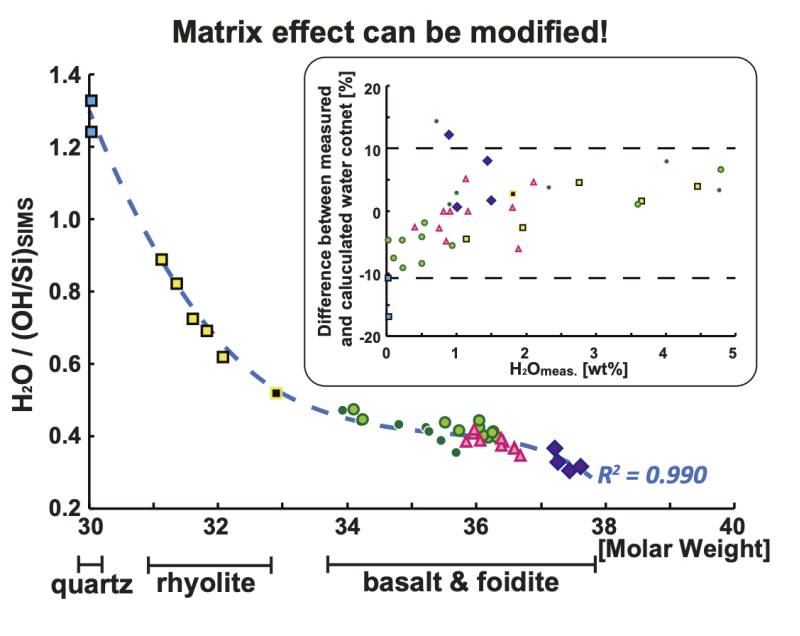
Modification for the matrix effect in SIMS-derived water contents of silicate glasses
ABSTRACT

Analyses of elemental abundances by secondary ion mass spectrometry (SIMS) require matrix-matched standard samples to account for the matrix effect on correction factors. This requirement makes it difficult to obtain accurate results for geological samples of variable chemistry. In this study, we prepared 39 volcanic glasses of foiditic, basaltic, basaltic andesitic, rhyolitic and pure SiO2 compositions, including synthetic samples and natural samples collected from the deep seafloor. The measured H2O contents of these samples were in the range 0.02–4.8 wt%. We showed that calibration curves (H2O content vs. 16OH–/30Si–SIMS ratio) differed according to the composition of the volcanic glasses. Our results demonstrated that for a particular 16OH/30SiSIMS ratio, water content could differ by up to a factor of five, depending on the composition of the volcanic glass. Although the correction factor (the slope of the calibration curve for water [H2O/(16OH–/30Si–)SIMS]) was weakly correlated with SiO2 content, we identified a stronger correlation with the molar weight (g mol–1, on a one-oxygen mole basis) of the silicate glasses. Our results suggest that modification of the correction factor for the matrix effect on SIMS-based H2O content of volcanic glasses according to their molar weights provides more accurate water contents of silicate glasses, regardless of their chemical composition and water content and without the need for a series of standard glasses of known water contents.
KEYWORDS
Keywords: SIMS, volcanic glasses, water content, matrix effect- Published : 2022
- Released on J-STAGE : 2022/12/22
- Received : 2022/06/10
- Accepted : 2022/11/10
- DOI : https://doi.org/10.2343/geochemj.GJ22019
- J-STAGE URL : https://www.jstage.jst.go.jp/article/geochemj/56/6/56_GJ22019/_article/-char/en
- J-Online ISSN: 1880-5973
- Print ISSN : 0016-7002
- ISSN-L : 0016-7002
All Issues
- Vol.59, 2025
- Vol.58, 2024
- Vol.57, 2023
- Vol.56, 2022
- Vol.55, 2021
- Vol.54, 2020
- Vol.53, 2019
- Vol.52, 2018
- Vol.51, 2017
- Vol.50, 2016
- Vol.49, 2015
- Vol.48, 2014
- Vol.47, 2013
- Vol.46, 2012
- Vol.45, 2011
- Vol.44, 2010
- Vol.43, 2009
- Vol.42, 2008
- Vol.41, 2007
- Vol.40, 2006
- Vol.39, 2005
- Vol.38, 2004
- Vol.37, 2003
- Vol.36, 2002
- Vol.35, 2001
- Vol.34, 2000
- Vol.33, 1999
- Vol.32, 1998
- Vol.31, 1997
- Vol.30, 1996
- Vol.29, 1995
- Vol.28, 1994
- Vol.27, 1993
- Vol.26, 1992
- Vol.25, 1991
- Vol.24, 1990
- Vol.23, 1989
- Vol.22, 1988
- Vol.21, 1987
- Vol.20, 1986
- Vol.19, 1985-1986
- Vol.18, 1984
- Vol.17, 1983
- Vol.16, 1982
- Vol.15, 1981
- Vol.14, 1980
- Vol.13, 1979
- Vol.12, 1978
- Vol.11, 1977
- Vol.10, 1976
- Vol.9, 1975
- Vol.8, 1974
- Vol.7, 1973
- Vol.6, 1972-1973
- Vol.5, 1971
- Vol.4, 1970-1971
- Vol.3, 1969-1970
- Vol.2, 1968
- Vol.1, 1966-1967




